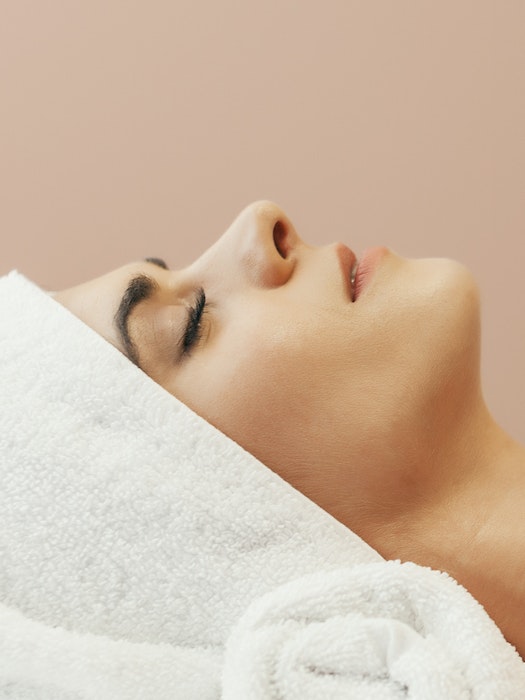Injectable Wrinkle Reducers
How to Help Fade Post-Inflammatory Hyperpigmentation ASAP
Thespotlyte | July 28, 23

So, you finally won the stand-off between you and that one pernicious pimple. Congratulations! But even if you resisted the temptation to pick at it, you may still see a resulting dark spot take its place. Also known as post-inflammatory hyperpigmentation, or PIH, this localized discoloration can last way longer than the original zit — and can be even harder to get rid of than the original offender in question.
PIH results from an over-production of melanin during the healing process. And it’s not just acne to blame. Any sort of trauma to the skin, be it a surgical incision, a mosquito bite, or even irritation, can result in PIH. It’s especially common among people of color, who have more melanin and are generally at a higher risk of developing it (though any skin tone can get it).
One key to help fade hyperpigmentation faster is getting to the bottom of whatever led to the PIH in the first place. “Was it acne? Was it a medication reaction? Was it a burn? Was it trauma to the skin? A surgical procedure? Was it an infection? Was it related to allergic contact dermatitis?” asks Seemal Desai, MD, FAAD, a board-certified dermatologist in Plano, Texas. “It’s always important to figure out what the underlying skin condition was that led to the post-inflammatory hyperpigmentation.” A dermatologist can work with you to determine the origin of your PIH.
This intel can help determine the best plan of attack. Although it depends on your specific case. “If it’s the type of hyperpigmentation that’s more superficial — meaning someone didn’t pick their acne — a lot of times we can clear that up topically,” says Tiffany Clay, MD, FAAD, a board-certified dermatologist in Atlanta, Georgia. If there was more trauma done to the skin (think absentminded picking), a laser may be in order. But there are no hard and fast rules when it comes to hyperpigmentation treatments. Here, some of the best options.
EDITOR’S NOTE
As always, talk to your doctor before starting any new treatment.
Post-Inflammatory Hyperpigmentation Treatment #1: Sunscreen
Sunscreen can help protect your skin against hyperpigmentation before it even sets in, as UV light can worsen PIH. “If you’re not protecting the skin from ultraviolet and other exposures like blue light, you’re allowing the hyperpigmentation to continue,” says Dr. Clay. “So, you definitely want to block ultraviolet rays by using a broad-spectrum SPF 30 or higher sunscreen each and every day.” It’s the single most important thing you can do to head off hyperpigmentation and help it fade faster. So, if you only do one thing, it should be this.
Post-Inflammatory Hyperpigmentation Treatment #2: Topical Products
There are a ton of topical options out there, and the right approach is multifactorial. It’s a combination of considering “the patient’s skin type, their aesthetic preferences, and where we want to move in a long-term cosmetic approach to that patient,” says Dr. Desai.
If the bulk of your hyperpigmentation is from acne, it’s helpful to treat both at the same time. “Especially for acne, I like to try to prevent it from happening by making sure that [patients] are using appropriate medication to prevent their breakouts,” says Dr. Clay. For that reason, she recommends a retinoid. Try Differin® ($29), which offers a prescription-level retinoid over-the-counter.
EDITOR’S NOTE
Of course, talk to your doctor before starting any new medication. Retinol shouldn’t be used by women who are pregnant, considering getting pregnant, or nursing. Please consult with your doctor before use.
As for other active ingredients, there are a number of spot-lightening ingredients to choose from — vitamin C, azelaic acid, kojic acid, and niacinamide are just a few that are easy to find in formulations. The exact one (or combo) depends on your hyperpigmentation and overall skin concerns. “Let’s say, for example, the PIH is due to acne or roscea,” Dr. Desai explains. “I’m more likely to use azelaic acid, because that ingredient has also been shown to be effective as an anti-inflammatory in those patients.” If you’re looking at PIH that’s resulted from sun damage, on the other hand, vitamin C may be better for you.
For even faster lightening, you can opt for a prescription-level cream. “Hydroquinone 4% is typically the most common formulation, and we combine that with a prescription retinoid and a steroid,” offers Dr. Desai. “We refer to that as triple-combination therapy.” There are creams available that contain all three — but again, you’ll need a prescription from your dermatologist to get it.
EDITOR’S NOTE
Hydroquinone has not been FDA-approved. Talk to your doctor before starting any treatment with it.
If you’re wary of hydroquinone, which is not approved by the FDA, and has been banned in the EU and other countries, you could try Senté® Cyspera®, a cream that uses cysteamine hydrochloride to lighten pigment. Unlike hydroquinone, it won’t affect any skin around the dark spot in question. It’s available through some doctors’ offices and medspas, and is well-tolerated long-term, which hydroquinone is not, says Dr. Clay.
With the right combination of topicals and your provider’s guidance, you should be able to see improvements in your PIH within two or three months. If not, you may need to consider stepping it up to an in-office treatment.

Post-Inflammatory Hyperpigmentation Treatment #3: Chemical Peels
After topical ingredients, your best bet may be chemical peels. Dr. Desai is a fan of chemical peels that pair alpha and beta hydroxy acids. “When you combine an alpha hydroxy acid [AHA] and a beta hydroxy acid [BHA], you’re putting two chemical peel ingredients together that work to improve the pigmentation and also rejuvenate the skin, which is super helpful,” he explains. While you can find these offered by derms and estheticians, Dr. Dennis Gross® Skincare Alpha Beta® Extra Strength Daily Peel ($88) is a decent at-home swap for dark spots.
AHA and BHA peels do tend to be lower-strength, which may be more preferable than a medium-strength peel with, say, TCA, or trichloroacetic acid. “[They] can cause further irritation on the skin and worsening of the hyperpigmentation,” he explains. Expect to do a consistent regimen of peels with AHAs and BHAs. If there’s not much of an improvement after a few weeks, you may then need to be bumped up to a TCA peel (under the supervision of a dermatologist, of course).
You can also use them in combination with topical hyperpigmentation treatments, since chemical peels leave skin sensitive to sunlight, and therefore may not be ideal depending on the time of year. “If someone were to do the topical medical treatments in the summer or spring months, then fall and winter would be a good time to really get aggressive with doing chemical peels more frequently to help decrease some of the hyperpigmentation in the skin,” explains Dr. Clay.
Post-Inflammatory Hyperpigmentation Treatment #4: Lasers
Lasers may be the fastest option here, but they’re also the riskiest — which is why many dermatologists only reserve them as their final option. “In darker skin patients, the laser itself may cause discoloration of the skin and may cause worsening trauma of the skin,” explains Dr. Desai. “So you want to be really careful, because we want to use the right treatment modality for the patient’s skin type.” Make sure your provider has years of experience in treating hyperpigmentation with lasers, and feel free to ask for a test spot in an inconspicuous area.
That being said, lasers can be a good option for stubborn PIH. “If the pigment is a lot deeper — in cases where maybe someone has really severe acne, or if they tended to be more of a picker and caused deeper hyperpigmentation — the laser is probably going to be a better option, because it can go deeper into the skin, where some of that leftover pigment likes to hang out,” says Dr. Clay. She’s a fan of newer picosecond and nanosecond lasers, which are effective at improving hyperpigmentation, and picosecond lasers do so with a lower risk of damaging darker-toned skin.
The extent of the hyperpigmentation, as well as the power of the laser used (whether it’s ablative or non-ablative, for instance), will ultimately determine how many sessions are needed to get the best results. They’re also your priciest option — but clearly, there are many options to choose from to treat post-inflammatory hyperpigmentation.
Learn more about hyperpigmentation:
- My Battle with Dark Spots — One Serum, Peel, and Laser at a Time
- TreatMEnt of the Week: The Hyperpigmentation-Blasting Fraxel Laser
- The Best Products for Minimizing the Look of Dark Spots on Skin, According to Dermatologists
Allergan® may receive commissions for purchases made through links in this article.










